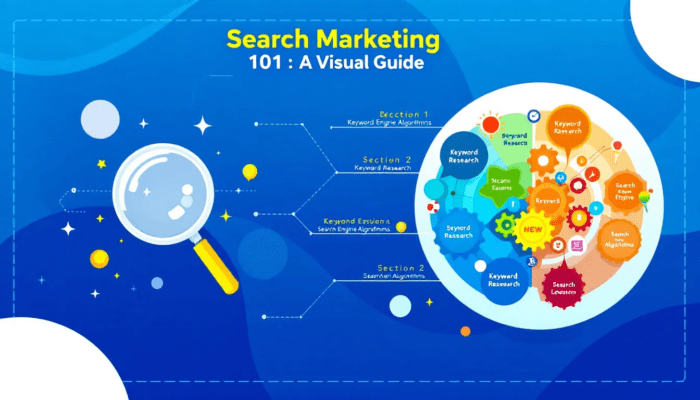Search marketing, which includes SEO and SEM, aims to increase your website’s visibility on search engines. It is key for attracting online traffic and boosting sales. This guide covers the basics of search marketing and its importance for your business.
Key Takeaways
- Search marketing combines SEO and SEM to improve online visibility. It captures both organic and paid traffic to drive leads and revenue.
- A robust search marketing strategy is essential as 91% of online adults use search engines, making it crucial for businesses to enhance their visibility and credibility.
- Effective search marketing requires thorough keyword research and the integration of both SEO and SEM tactics to maximize audience reach and performance.
Understanding Search Engine Marketing

Search marketing is a versatile digital strategy that employs both paid and unpaid methods to boost online visibility. At its core, it encompasses two fundamental elements: search engine optimization (SEO) and search engine marketing (SEM). While SEO focuses on optimizing your website to rank higher in organic search results, SEM primarily revolves around paid search marketing strategies, such as Pay-Per-Click (PPC) advertising.
Think of search marketing as an umbrella encompassing both SEO and SEM. SEO seeks to improve your website’s visibility on search engine results pages (SERPs) through various techniques, such as on-page optimization, technical SEO, content creation, and organic search marketing.
On the other hand, SEM, which includes platforms like Google Ads (formerly Google AdWords), targets users through paid search ads that appear on SERPs based on specific keywords.
The beauty of search marketing lies in its ability to capture both organic and paid traffic. SEO and SEM create a powerful synergy that maximizes online presence, driving more traffic, leads, and revenue. A well-rounded search marketing strategy enhances your website’s visibility and ensures you stay competitive in the crowded online marketplace.
Importance of Search Marketing

Why is search marketing so vital for businesses today? Consider this: 91% of online adults use search engines regularly, highlighting their pivotal role in the consumer journey. As more consumers turn to search engines for solutions, having a robust search marketing strategy becomes indispensable for any business aiming to stay relevant and visible.
Search engine marketing, particularly through paid strategies, enhances content visibility on search engine results pages. Investing in strategies like Google Ads helps companies ensure their products and services appear prominently in search results, increasing their chances of discovery by potential customers. Consistent visibility boosts brand awareness and establishes credibility and trust among users.
Moreover, search marketing is not just about reaching a global audience. Local search engine marketing significantly improves visibility for businesses with physical locations, ensuring they appear in local searches and attract nearby customers. By integrating organic and paid strategies, businesses can effectively enhance their online presence, driving more website traffic and higher conversion rates.
Components of Search Marketing
The two main pillars of search marketing are SEO and SEM, each playing a unique yet complementary role in enhancing your online presence. SEO focuses on optimizing your website to improve its ranking in organic search results, increasing visibility, and driving organic traffic. On the other hand, SEM is centered around paid advertising strategies that help businesses reach potential customers searching for related products or services.
A successful search marketing strategy requires a coordinated approach between SEO and SEM. Integrating both components allows businesses to capture a broader audience and maximize results. SEO lays the foundation for long-term visibility and authority, while SEM provides immediate traffic and quick wins through targeted paid ads.
Together, they form a comprehensive strategy that covers all bases, ensuring sustained growth and competitive advantage in the digital marketplace.
SEO Fundamentals
Search engine optimization (SEO) enhances the quality and quantity of traffic to your website through organic search results. The primary goal of SEO is to improve your website’s visibility on search engine results pages (SERPs) by making it more attractive to search engines like Google. This involves on-page optimizations, technical SEO fixes, and off-page strategies like building backlinks.
Several factors affect your SEO performance, including how well your site is indexed by search engines and the relevance of your content to search queries. Search engines use complex algorithms to rank web pages, considering signals like text content, backlinks, and user engagement. Optimizing your site for SEO involves creating high-quality, relevant content and ensuring your website is technically sound and user-friendly.
Keep in mind that SEO is a long-term strategy. While it may take three to six months to see significant results, the benefits of improved organic visibility are well worth the effort. Regularly refreshing content and optimizing site elements significantly improve your rankings on SERPs, driving more organic traffic to your website.
SEM Essentials
Search Engine Marketing (SEM) primarily focuses on paid advertising strategies to increase visibility and drive traffic to your website. The primary function of SEM is to promote your business, products, and services through paid ads, often using platforms like Google Ads (formerly Google AdWords). SEM campaigns typically involve Pay-Per-Click (PPC) advertising, where you pay a fee each time your ads are clicked.
One of the main advantages of SEM is the ability to drive traffic and see immediate results quickly. Unlike SEO, which takes time to build, SEM can instantly place your ads at the top of search results, providing a fast track to increased visibility. To run an effective SEM campaign, targeting specific keywords that align with your audience’s search intent is crucial. This involves choosing commercial and transactional keywords that are likely to convert.
SEM also allows for precise targeting based on location, device, and time of day. By entering ad auctions and selecting the right keywords, you can ensure your ads reach the most relevant audience. Moreover, SEM ads often appear at the top or bottom of search results, making them highly visible to potential customers.
How Search Marketing Works

Search marketing leverages immediate and long-term tactics to drive traffic to your website. SEM generates immediate traffic through paid ads, while SEO builds long-term traffic through organic search visibility. A solid search marketing strategy begins with thorough keyword research, which benefits both SEO and SEM efforts. Identifying the right keywords ensures your content and ads are aligned with what your target audience is searching for.
Using SEM enables businesses to access detailed performance data, allowing for continuous optimization of their sem strategy. This data can be used to test different ad copies and landing pages, making refining your approach over time easier.
However, businesses may struggle to measure and scale their marketing efforts without a structured strategy.
Conducting Keyword Research
Keyword research is the cornerstone of effective search marketing. It involves identifying your target audience's search terms and phrases when looking for products or services like yours. Understanding keyword intent helps tailor your content and ads to meet user expectations, increasing the chances of engagement.
Tools like the Keyword Magic Tool can help you identify relevant keywords and understand their search intent. To gauge relevance, it’s essential to consider keyword volume, which indicates the average number of monthly searches for a particular term. Keeping track of SEO and SEM keywords separately ensures you stay organized and can effectively target each aspect of your search marketing strategy.
Regularly updating your keyword list helps you stay competitive. New keywords emerge as market trends change, and continuous research helps you stay relevant and capture more organic traffic. Additionally, considering the cost-per-click (CPC) for keywords is vital for evaluating the financial feasibility of your SEM campaigns.
Creating Effective Ad Campaigns
Creating successful ad campaigns involves more than just selecting the right keywords. It’s about striking a balance between relevant terms and avoiding irrelevant ones that could waste your budget. The competitiveness of keywords significantly impacts their cost, so it’s essential to choose wisely. Tools like Semrush’s Advertising Research tool can provide insights into your competitors’ ad strategies, helping you refine your own.
An effective SEM campaign allows you to use up to 15 headlines to attract attention, each with a maximum character limit of 30. These headlines should be clear, specific, and compelling to capture the interest of your target audience. Once your ads are approved, SEM can show immediate results, enabling you to track performance and make necessary adjustments.
A well-structured Google Ads account is crucial for effective strategic bids. Organizing your ads topically and ensuring a high-quality landing page experience can significantly boost your campaign’s performance. This includes consistent messaging, a positive user experience, intuitive navigation, and fast loading speeds.
Benefits of Search Marketing

The benefits of search marketing are manifold. Here are some key advantages:
- Positioning your ads at the top of search results with SEM significantly boosts website traffic and enhances click-through rates.
- This increased visibility translates into more traffic and, consequently, more revenue.
- With targeted advertising, businesses can reach exactly the audience that matches their ideal customer profiles, ensuring more effective and efficient marketing campaigns.
Search marketing is also budget-friendly. With PPC advertising, businesses pay only when users engage with their ads, making it a cost-effective strategy. Combining SEO, which builds long-term value and authority, with SEM, which offers immediate visibility, delivers the best results for most businesses. This dual approach ensures both short-term gains and sustained growth.
SEO vs. SEM: Key Differences
While SEO and SEM aim to enhance your website’s visibility, they do so through different methods. SEO represents the organic part of search engine marketing, focusing on improving your website’s content and performance to rank higher in organic search results. On the other hand, SEM includes both paid and organic methods but is more focused on paid strategies like PPC advertising.
SEO is free traffic after the initial effort, whereas SEM requires continuous payment for each click. Despite these differences, SEO and SEM should complement each other in a well-rounded search marketing strategy. Integrating both creates a competitive edge, allowing your business to stand out even against larger competitors.
Best Practices for Search Marketing
To maximize the effectiveness of your search marketing efforts, it’s crucial to update and revise your strategies regularly. High-quality content is key—producing relevant and valuable content that resonates with your target audience can significantly enhance your SEO and SEM performance.
Creating relevant and high-quality ads is crucial for achieving the best SEM results.
Optimizing Your Website for SEO
A well-organized website structure is fundamental for SEO success. Clear navigation and a logical hierarchy help search engines crawl and index your site efficiently, improving your visibility in search results. Creating high-quality, relevant content tailored to your target audience is crucial for ranking well on SERPs. Naturally, incorporating keywords into your content can further enhance your chances of ranking for those terms.
Regularly updating your content keeps it fresh and relevant, encouraging search engines to revisit and index your site more frequently. Technical aspects, such as fast loading times and mobile compatibility, are also vital for improving user experience and reducing bounce rates.
Implementing appropriate meta tags, alt attributes, and structured data helps search engines understand and index your content more effectively.
Enhancing SEM Performance
Enhancing SEM performance involves strategically using negative keywords to refine your target audience and reduce wasted ad spend. Regularly testing ad copy to identify which messages resonate best with your audience is crucial for optimizing your SEM campaigns.
Continuously refining your approach maximizes the effectiveness of your paid search marketing efforts.
Common Mistakes in Search Marketing
One common mistake in search marketing is failing to track SEM metrics. Without proper tracking, it’s challenging to evaluate the performance of your paid ads and make data-driven adjustments.
The right tools and processes to monitor these metrics are essential for optimizing your search marketing strategies.
Tools for Search Marketing
Using the right tools is crucial for the success of your search marketing efforts. Analytics and reporting tools like Google Analytics enable you to track SEM performance and make data-driven campaign adjustments. These tools provide detailed insights into your ads' performance, helping you optimize your strategies for better results.
Competitor analysis tools like Semrush and Similarweb are invaluable for understanding where your competitors’ traffic originates and what keywords they are targeting. Semrush, in particular, is essential for keyword analysis and overall SEM efforts, while Similarweb focuses on domain-level data to give you a comprehensive view of your competitive landscape.
For email marketers, tools like Owletter help track competitors’ email campaigns and analyze their strategies efficiently. Additionally, LowFruits provides a cost-effective solution for competitor keyword research by identifying low-competition keyword variations. These tools collectively enhance your ability to execute effective search marketing strategies.
Future Trends in Search Marketing

The future of search marketing is poised for exciting developments. The global SEO market is expected to experience substantial growth, reaching $122.11 billion by the year 2028. As the landscape evolves, companies will need to rely more on individual expertise in SEM, especially with the increasing use of first-party data and the decreasing dependence on external data sources.
Technological advancements such as AI and automation are expected to limit the levers available to SEM professionals, affecting their spending control. Moreover, visual search technology and augmented reality are rising, providing consumers with more immersive and interactive experiences. Programmatic advertising is also evolving, offering more automated and data-driven marketing strategies.
Summary
Search marketing is an indispensable part of any digital marketing strategy. By combining the strengths of SEO and SEM, businesses can achieve immediate visibility and long-term growth. Understanding the components, conducting thorough keyword research, and creating effective ad campaigns are crucial to maximizing your online presence. As search marketing evolves, staying updated with the latest trends and best practices will ensure your strategies remain effective and competitive. Embrace the power of search marketing, and watch your business flourish in the digital landscape.

Frequently Asked Questions
What is the difference between SEO and SEM?
SEO improves organic search visibility through content and performance optimizations, whereas SEM encompasses both paid and organic methods, primarily focusing on paid strategies like PPC advertising.
Why is keyword research important in search marketing?
Keyword research is crucial in search marketing. It uncovers the specific terms your audience uses, enabling you to align your content and ads effectively. This targeted approach enhances engagement and boosts traffic to your site.
How can businesses benefit from search marketing?
Businesses can significantly benefit from search marketing by increasing website traffic and enhancing brand visibility, which can lead to higher revenue through targeted advertising strategies.
What are some common mistakes in search marketing?
A crucial mistake in search marketing is neglecting to track SEM metrics, which hinders your ability to optimize campaigns effectively. Additionally, failing to conduct thorough keyword research and not regularly updating your strategies can significantly impact your success.
What tools are essential for search marketing?
Essential tools for effective search marketing include Google Analytics for tracking performance, Semrush for keyword analysis, Similarweb for competitor insights, and Owletter for email marketing. These tools help optimize strategies and improve overall marketing performance.

Unlock the Power of Search Engine Marketing
Ready to harness search marketing's potential to grow your business? At Asymmetric Marketing, we specialize in strategies that drive visibility, engagement, and conversions.
Explore More Insights
- Discover actionable tips and strategies.
Start Your Search Marketing Journey
- Have questions or need tailored advice? Contact Us
- Ready to elevate your search marketing game? Schedule a Consultation Today
Don’t miss the opportunity to attract customers and dominate search results with a customized marketing strategy!
About the author
Mark A. Hope is the co-founder and Partner at Asymmetric Marketing, an innovative agency dedicated to creating high-performance sales and marketing systems, campaigns, processes, and strategies tailored for small businesses. With extensive experience spanning various industries, Asymmetric Marketing excels in delivering customized solutions that drive growth and success. If you’re looking to implement the strategies discussed in this article or need expert guidance on enhancing your marketing efforts, Mark is here to help. Contact him at 608-410-4450 or via email at mark.hope@asymmetric.pro.

